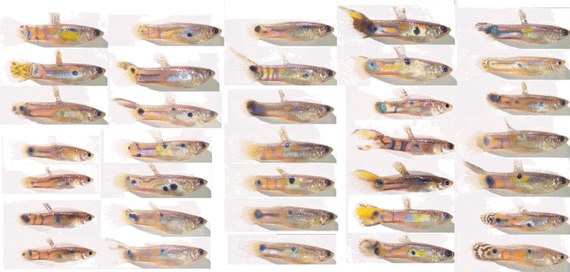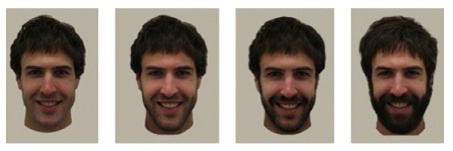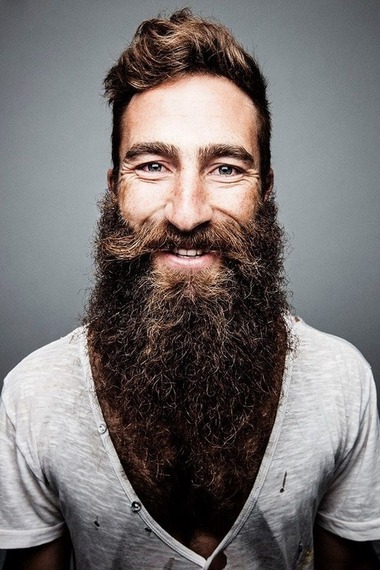
If you haven't been outdoors in a few years, you might not have noticed that beards are back. In fact, they're back in such a big way that many New York hipsters apparently are paying north of $8,000 for "facial hair transplants" to embellish their patchy beards.
While the hipster subculture appears to be ground zero for the latest swerve toward beardedness, men who would not be seen dead in skinny jeans or thrift-shop cardigans are letting the whiskers grow in a way that hasn't been fashionable for decades.
Why are beards sprouting from the unlikeliest faces? And is there anything that might make them stop?
The Advantage of Rarity
In Biology Letters we provide experimental insights into why beard fashions come and go, and why there is no single optimum pattern of facial hair. By "we" I mean my former honors student Zinnia Janif, my colleague (and Zinnia's co-supervisor) Dr. Barnaby Dixson and me.
We speculated that a phenomenon called "negative-frequency dependence" (NFD) might help explain diversity in facial-hair patterns. Negative-frequency dependence simply means that rare traits enjoy an advantage.
In evolutionary genetics, NFD selection is an important force, favoring rare genetic alleles over more common ones. In guppies, for example, males bearing rare combinations of colored spots are both less likely to be preyed on and more likely to gain matings in the wild. So a rare color pattern can spread very rapidly until it becomes so common that it attracts attention from predatory fish and starts looking like old hat to female guppies.
A sample of male guppies caught from Alligator Creek, North Queensland, where they occur ferally. The size and placement of color spots in male guppies are among the most genetically variable traits yet studied. (Photo by Rob Brooks)
The selective advantages enjoyed by rare color patterns explain why guppy color patterns are among the most genetically variable traits yet studied. Could more subtle forms of NFD selection explain why so much genetic variation persists in most traits, even though natural selection is expected to remove genetic variation by eliminating "bad" genes? Under NFD, "good" or "bad" depends on how common the gene is.
What if, we speculated, rarity also operated in the world of fashion? In this case, what if rare patterns of facial hair enjoy an advantage purely on account of their rarity?
Experiment
To test this idea we set up a simple experiment using a suite of photographs of 36 men. Each man had been photographed when clean-shaven, with five days of growth (we call this light stubble), with 10 days of growth (heavy stubble) and with at least four weeks of untrimmed growth (full beard).
(Photo by Barnaby Dixson)
Subjects, recruited via our research group's webpage (where we are always seeking subjects) and Facebook (thanks for the traffic, IFLS), each rated 36 faces, one of each man. Over the first 24 faces we manipulated the rarity of beard types. Subjects either saw all 24 men clean-shaven, all 24 with full beards, or six men from each of the four levels of beardedness.
We then analyzed how subjects rated the same -- last -- 12 pictures comprising three from each beard level. In line with our prediction, when clean-shaven faces were rare (among the early 24 pictures), they enjoyed a significant premium in attractiveness ratings (in the last 12) over when they were common. And when full beards were rare, or when the four levels of beardedness were evenly distributed, full beards enjoyed significantly higher attractiveness than when full beards were common. Five- and 10-day stubble did not really vary in attractiveness across the three treatments.
What this means is that, under experimental conditions, at least, patterns of facial hair enjoy greater attractiveness when they are rare than when they are common. Whether this scales to more nuanced judgments in the more complex and varied real world remains to be seen, but it suggests that beard styles are likely to grow less attractive as they become more popular, and that innovative new styles may enjoy a premium while they are still rare.
Fashion and Facial Hair
Negative-frequency-dependent choices might well be an important ingredient in changing facial-hair fashions. The current fad for facial hair is just the latest development in a long history.
Dwight E. Robinson went to the trouble of scoring the facial grooming of all men pictured in the Illustrated London News between 1842 and 1972. In the 1890s, more than 90 percent of men pictured had some form of facial hair, a figure that dropped to below 20 percent by 1970. Sideburns occupied the news in the mid-19th century, whereas full beards reigned from 1870 to 1900, only to be replaced by mustaches.
Negative-frequency dependence might play a role early in an establishing fashion.
The New York Times reckons the current beard trend emerged among local hipsters in late 2005. I'm not sure The New York Times would notice anything that happened or -- heaven forbid -- started outside Manhattan or Brooklyn, but suffice it to say the current fashion has been almost a decade in the making.
Noveau-beard has been propelled along the way by various sportsmen, movie stars and musicians. But the fashion has now spread to the point where astute commentators reckon the tide of hipster cool has turned. When Buzzfeed breathlessly lists the "51 Hottest Hollywood Beards," it's time to seek higher ground to avoid the tsunami set off by the implosion of cool.
That is one way in which negative-frequency dependence can work: When a fashion goes mainstream, it loses the advantage of rarity. And so it begins to subside.
Not Everybody Should Grow a Beard
Much of this discussion has concerned the attractiveness of beards, but although many hirsute men have formed the zealous conviction that their beards place them at an advantage with the ladies, evidence is far more equivocal.
Dixson's previous research has shown that heavy stubble -- a substantial growth that is well kept -- is more attractive than a clean-shaven face, light stubble or a full beard. And individual women vary in their tastes: Some are pro- and others vehemently anti-whisker.
Far less ambiguously, beards tend to make those men who can grow them look more masculine. That's hardly surprising, actually, given that the ability to grow facial hair kicks in during puberty, marking the transition to manhood. The beard might be as much a signal to other men as it is to women, which might explain why so many warrior cultures grew resplendent beards, and why professional sports teams grow beards in playoff-time solidarity.
Female attraction to bearded men can arise due to the manly connotations of facial hair. Nicki Daniels certainly makes this point in her hilarious open letter to bearded hipsters:
Unfortunately, you guys have turned it into a fashion statement. The beard has turned into the padded bra of masculinity. Sure it looks sexy, but whatcha got under there? There's a whole generation running around looking like lumberjacks, and most of you can't change a fucking tire.
If the messages signaled by growing facial hair are diminished when every man-boy over 20 is sporting a beard, that constitutes another way in which negative-frequency-dependent choice might work.
The reasons that beards diminish in value when everyone is wearing them remain to be teased apart, but the fact that they do suggests that the hipster beard, like the handlebar mustache, the mutton chop and countless other fashions before them, will, in time, pass.
P.S. Beard Season Is Coming Up
"Jimmy Niggles" grew Australia's highest-profile contemporary beard to raise awareness about melanoma. Now he's looking to sell it for A$1 million to support cancer research. (Photo by Tim Jones)
You may already have encountered "Jimmy Niggles" (aka Scott Maggs) and his friends, who are raising awareness about melanoma -- in honor of their mate Wes, who lost his life to melanoma at age 26 -- through their Beard Season campaign. Jimmy uses his resplendent beard to start conversations with strangers (and leverage considerable media interest) about the importance of having their skin checked. Jimmy is currently selling his beard for A$1 million in order to raise money for melanoma research.
Talk about a positive expression of contemporary masculinity.
Rob Brooks does not work for, consult to, own shares in or receive funding from any company or organization that would benefit from this blog post and has no relevant affiliations.
This blog post was originally published on The Conversation. Read the original post here.


